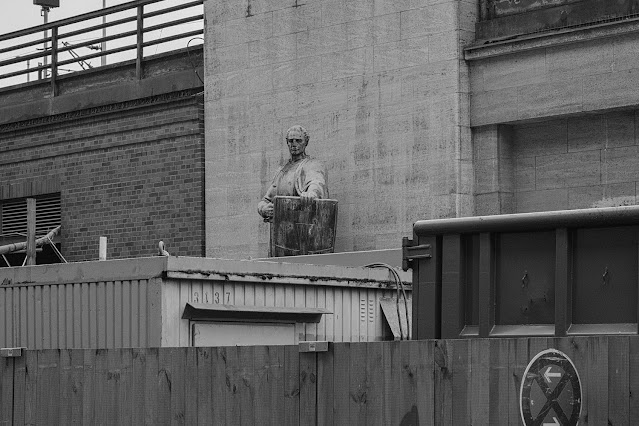Photographers have long tried to document residual or ghosted histories. In examples like Sally Mann’s Deep South, Jessica Ingram’s Road Through Midnight, or Simon Norfolk’s work in Serbia and Ireland, photographers have used a variety of strategies and techniques to visualize abstract and historical presences. In his new book Vaterland, Jörg Colberg attempts to ask similar questions about the lingering effects of World War II by looking at landscapes and cities in Eastern Europe.
Photographed in Poland and Germany between 2016 and 2019, Vaterland (German for fatherland) is divided into two basic parts. The bulk of the book is composed of Colberg’s pictures, but ends with a compilation of data presented in German, English, and Polish. This data juxtaposes information on World War II — about the death toll across Europe, numbers of Jewish people killed during the Holocaust, and the damage to Warsaw’s infrastructure during the German occupation — with information on contemporary German politics and social conflicts — about the rising violence against refugees and the recent rise in conservative and fundamentalist movements.
 |
The photographs themselves are very simple, reminiscent of some of the great Cold War era photography coming from Berlin (it’s easy to assume that Colberg has spent a great deal of time with the Michael Schmidt’s Waffenruhe and John Gossage’s work from Berlin). The pictures are strong and well visualized, presented in a rich, cool-toned black-and-white. The opening sequence clearly expresses Colberg’s intended narrative, as he takes the viewer from expansive landscapes that exist in an in-between space of development and dilapidation, to closer details of disenfranchised commercial and residential spaces, to humble interiors, and finally to a simple portrait of a young man growing up amidst the complex history of Eastern Europe. We see the landscape and culture moving forward, or at least trying to, but, nevertheless, it feels stuck. The combined effect reminds me of the famous line by William Faulkner: “The past is never dead. It’s not even past.” All of us, like the young man in the first portrait, carry the burden of our cultural history, of communities that try to grow but are held back by the weight of their histories.
The design of the book is simple, even stoical, with one photograph per page spread. The book is a small paperback, beautifully printed on bright white, coated paper. The austerity of the production somehow seems appropriate, as a realistic view of European history requires a somber understanding of both the present and the possibilities that the future has in store. I find the simplicity of this book refreshing — in an age of lavish and opulent book production, a small and simple object can still speak volumes.
I must confess, however, to being extremely divided in my response to Vaterland. Colberg has a strong visual sensibility with a real understanding and appreciation of the book as a photographic form. My hesitation comes from his visual references. His style, approach and subject matter seem too grounded in Cold War era photography and too indebted to his influences. I grew up during the Cold War — I was in high school when the Berlin Wall fell — and share a strong affinity with the photographers that feel like the primary influences of this work. But I also feel that there is more to the contemporary landscapes of these cities than just the data collated at the end of the book. I agree that the past is never past, but I also know that the complexities of time are relentless; while the past may still be, the same is true of the present and future, ideas that feel vacant from these photographs.
 |
About a year ago, Colberg released Photography’s Neoliberal Realism, a treatise that questioned the significance of photographic icons like Andreas Gursky and Gregory Crewdson, specifically calling their work a sort of capitalist propaganda, not unlike the great socialist work coming from the Soviet block a hundred years ago. It’s interesting to think of this book in relation to Vaterland, a meditation on the impacts of fascism on contemporary Germany. I find myself most interested in a question that exists between these two books. It’s not something I can put my finger on, but it feels like an ambitious question that challenges contemporary discursive and social norms. I look forward to seeing how Colberg continues to address these ideas as his work continues to develop.
Purchase Book
Read More Book Reviews
 |
 |
Brian Arnold is a photographer and writer based in Ithaca, NY, where he works as an Indonesian language translator for the Southeast Asia Program at Cornell University. He has published two books on photography, Alternate Processes in Photography: Technique, History, and Creative Potential (Oxford University Press, 2017) and Identity Crisis: Reflections on Public and Private and Life in Contemporary Javanese Photography (Afterhours Books/Johnson Museum of Art, 2017). Brian has two more books due for release in 2021, A History of Photography in Indonesia: Essays on Photography from the Colonial Era to the Digital Age (Afterhours Books) and From Out of Darkness (Catfish Books).











